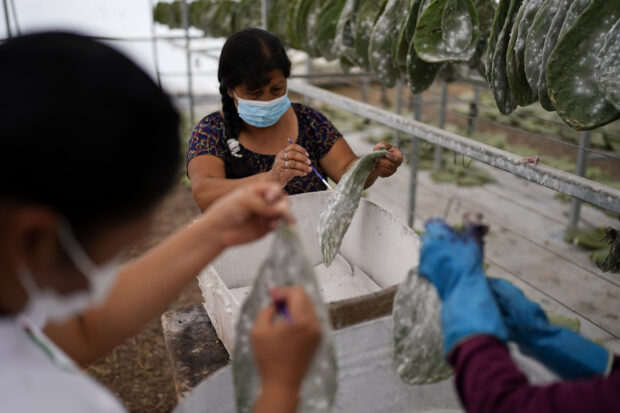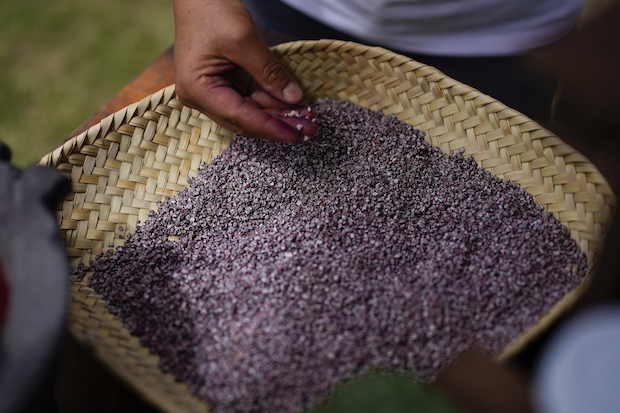Mexican family still makes valuable red dye the old way

Using paint brushes, Garcia family members, Mayeli, left, Araceli, and Galdina, gently scrape off tiny female insects known as Dactylopius coccus from nopal cactus pads, in their greenhouse in San Francisco Tepeyacac, east of Mexico City, Thursday, Aug. 24, 2023. The Garcia family preserves the old-fashioned production of cochineal dye, an intense, natural red pigment, that comes from the crushed bodies of the tiny female insects that contain carminic acid. (Photo by EDUARDO VERDUGO / AP)
SAN FRANCISCO TEPEYACAC, Mexico — One family in central Mexico is struggling to preserve the production of cochineal dye, an intense, natural red pigment so prized that, after gold and silver, it was probably the most valuable thing the Spaniards found in Mexico after the 1521 conquest.
For centuries, red clothing — along with purple — had been a sign of power and wealth because it was rare and expensive. An indigenous Mexican process deriving the pigment from insects gave the Spanish empire a new source of red dye.
Some of Mexico’s most picturesque and imposing colonial cities, like Oaxaca, were essentially built on the wealth derived from cochineal dye, also called carmine, and known as “grana cochinilla” in Spanish. It was much prized by the Spanish nobility, and it would go on to dye, among other garments, the British Empire’s ‘Redcoat’ military uniforms, before it began to be replaced by synthetic dyes in the 1800s.
Obtaining the dye the old-fashioned way is slow, tedious, and painstaking. It comes from the crushed bodies of tiny female insects that contain carminic acid and feed on the pads of nopal cactus plants.
Each insect, known as Dactylopius coccus, must be bred to a larvae stage and “planted” on a previously wounded cactus pad, and then left for months to feed and mature.
Article continues after this advertisementThen each must be harvested by hand, usually with a tiny brush, sifted, cleaned, and left to dry in the sun.
Article continues after this advertisement
Mayeli Garcia inspects dried, crushed tiny female insects known as Dactylopius coccus, at the family’s cochineal farm in San Francisco Tepeyacac, east of Mexico City., Thursday, Aug. 24, 2023. Centuries before the Spaniards arrived the Mixtecs of Oaxaca developed the method the Garcias use to obtain carminic acid from the tiny insects that is used to produce cochineal dye, an intense, natural red pigment. (Photo by EDUCARDO VERDUGO / AP)
The Mixtecs of Oaxaca first developed the method to obtain the precious pigment centuries before the Spaniards arrived. A symbol of status, carmine red was already employed by the nobility of Mexico’s Indigenous peoples to dye garments and widely used in the arts, to write codices, decorate ceramics, and paint murals.
Mayeli Garcia and her family run a greenhouse in the village of San Francisco Tepeyacac, east of Mexico City, which specializes in the slow, old production process.
At their greenhouse, rows of hundreds of cactus pads are held on racks suspended in the air and covered by a white powder. That is the sign of the insects working beneath, drawing nourishment from the juices of the nopal and protecting themselves with the waxy powder.
“You have to wait three or four months for them to complete their life cycle, and then we harvest,” Garcia said. “You have to keep monitoring and watching every cactus pad.”
That’s essentially the way the best red was produced for three centuries.
By the 1800s, synthetic chemical dyes, cheaper to produce and more plentiful, began to replace cochineal dyes.
But the story doesn’t end there. Artisans in Oaxaca maintained some production because weavers of traditional clothing and rugs preferred it in handicrafts.
Some studies began suggesting that chemical dyes — and particularly some of the red ones — could have adverse health effects if consumed as food colorings or in cosmetics like lipstick. By 1990, US authorities banned red dye No. 3 for use in cosmetics, though it is still allowed in food products.
Those concerns have begun to spur the demand for natural colorings — and there was Mexico’s cochineal dye all along.
Companies that might want it on an industrial scale are out of luck. It simply isn’t available in such quantities.
“We have tried to automate a little bit to make it less manual work, with machinery we ourselves invented, to try some brushes” for brushing the insects off the cactus pads, Garcia said. The motor of their prototype burned out, she noted ruefully.
Garcia struggles to make a living off the 100 kilograms (220 pounds) of cochineal dye she produces each year, though she is trying to diversify into soaps, creams, cosmetics, and other products derived from the nopal, such as jam.
Her family still grows fresh vegetables to make ends meet. Selling the dye for less isn’t an option.
“It is a lot of work, very labor intensive. It costs too much to produce in terms of labor, so the cost is difficult,” she said.
But she still has plenty of reasons for keeping on with the cochineal farm, a whole ecosystem designed to keep the tiny bugs happy, well-fed, and safe from predators.
“We are having problems with synthetics and chemicals,” she said. “So I think that there is a revolution going on, of returning to what once was, what was once produced because it kept us much healthier.”